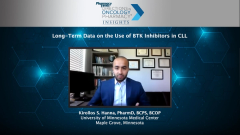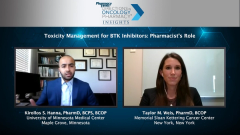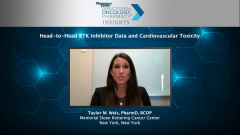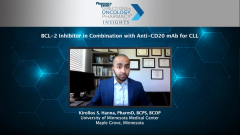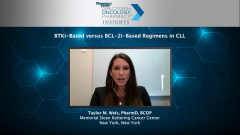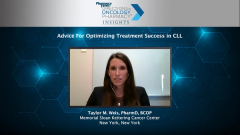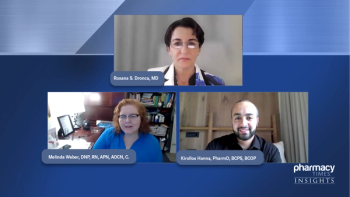
Therapy Initiation and Treatment Goals in CLL
Experts discuss triggers for initiating therapy in a patient with CLL, in addition to the goals of therapy.
Episodes in this series

Kirollos S. Hanna, PharmD, BCPS, BCOP: There is one thing I wanted to ask you and get your opinion on. Now, with all of these novel therapies and these oral BTK [Bruton tyrosine kinase] inhibitors, most of our patients can be treated. Again, CLL [chronic lymphocytic leukemia] is a chronic disease. They can be taking oral chemotherapy, 1 tablet once a day, for example, such as ibrutinib, just at home. Are there specific triggers that lead you to initiate therapy? One thing for example for me, is I remember when I was getting out of residency and studying all of these disease states, many patients with CLL or SLL [small lymphocytic lymphoma] fell into the watch-and-wait period, which is what we called it. Their lymphocyte count is slightly high. They don’t have any major cytopenias or infections or significant complications. When you are looking at initiating therapy, are there specific things you look for, what we call triggers in starting therapy?
Taylor M. Weis, PharmD, BCOP: Absolutely. This is one area that hasn’t changed much in the last few years. There’s still a large patient population with CLL that could be observed for years without needing more treatment or maybe never needing treatment. Our real triggers to start therapy are patients who we consider to have active symptomatic or progressive disease, and this can be met by a few criteria. One of them being evidence of bone marrow failure. This can be a patient’s hemoglobin declining. They may have a transfusion requirement, or platelets that are declining. Another thing is symptomatic disease. Those patients have constitutional symptoms like fevers, chills, drenching night sweats, which can really impact a patient’s quality of life. Sometimes patients can have unintentional weight loss. They say, “I’m eating, but I’ve lost 10 pounds in the last month.” Also, some patients can have such profound fatigue that it impacts their performance status and their ability to do their normal activities throughout their day. Some patients may have really bulky progressive lymph nodes or splenomegaly that can be symptomatic. There are some cases where patients have autoimmune complications. Patients may have hemolytic anemias or ITP [immune thrombocytopenia], which may be associated with their CLL. We often try to start some sort of treatment for them. We have looked at patients with asymptomatic early stage disease, and going ahead and preemptively starting them on therapy. However, what we saw is that these patients really didn’t have any survival benefit from that, and we were just prolonging the time they were on treatment or treating them without any potential benefit. Thus, we still reserve treatment for those patients with symptomatic, active disease.
Kirollos S. Hanna, PharmD, BCPS, BCOP: That’s very good to know. We do the same thing. I have a family member who is in this watch-and-wait category. Younger but doing very well, just slight changes in the lymphocyte counts. It’s very interesting to hear that there are some similarities there between our institutions. I also had one other question along the lines of this topic. So, say now we do have our patient who is symptomatic. They have the B symptoms. We have been watching this patient for a couple of years now, and we are going to initiate therapy. What are the goals you’re seeing in clinical practice, and whether it’s the guidelines of what’s being recommended, in terms of therapy? One thing you mentioned is most patients are older. When we are selecting therapy, is it solely based on tolerability, knowing that BTK inhibitors have now been around for several years and patients are doing well on therapy, and they only take X number of pills once a day or a couple times a day? Are you doing more fixed-duration approaches, where you’re combining BCL2 [inhibitors] and anti-CD20 [monoclonal antibodies]? We’re going to talk more about the data a little later, like CLL-14 and the MURANO trial, combining BCL2 with anti-CD20. But how are we making those distinctions? It tends to be a little hard I think sometimes for some patients, but are these discussions we are having with patients? Are we just defaulting to BTK? What are your opinions there?
Taylor M. Weis, PharmD, BCOP: Yes, it’s not a one-size-fits-all approach. We talk to every patient before starting therapy. We actively involve them in the discussion of treatment selection. We’ll get into this later, but these treatments are very different in their [adverse] effect profiles, how they’re administered, how often the patient will have to come to the clinic for monitoring. The ultimate goal we try to keep in mind for these patients is that we want them to feel better. Our triggers for therapy are symptomatic disease, and so ultimately, we want to control those symptoms. We want the patient to feel better. We want them to feel better for longer, and we want them to live longer. Thus, we really keep that in the back of our mind when we are explaining these therapies to our patients, and we don’t have any direct head-to-head comparisons of BTK inhibitors versus BCL2 inhibitor-based approaches at this time. Hence, sometimes it comes down to patient preference.
Transcript edited for clarity.
Newsletter
Stay informed on drug updates, treatment guidelines, and pharmacy practice trends—subscribe to Pharmacy Times for weekly clinical insights.



